Birdfinding.info ⇒ After a very close brush with extinction in the 1930s and ’40s, the Short-tailed Albatross has rebounded to viability. It is fairly common in Japanese waters from Hokkaido south to the Izu Islands, and can often be seen on the offshore ferry routes and on pelagic trips from Honshu—especially during the breeding season, from October to May. During the 2000s it has been seen increasingly often on pelagic trips out of North American ports everywhere from south-coastal Alaska to southern California, though it remains a rarity east of the Aleutians.
Short-tailed Albatross
Phoebastria albatrus
Breeds on offshore islands of Japan; disperses throughout the North Pacific.
Breeding. Nests on open slopes of remote volcanic islands. Adults arrive at their colonies in October. Juveniles fledge in April or May.
The main breeding colony is on Torishima in the Izu Islands, where a 2018-19 census found 1,011 pairs and more than 5,000 individuals.
There are much smaller colonies in the Senkaku Islands (10-20 pairs on Kita-kojima and Minami-kojima), the Ogasawara Islands (on Mukojima, where reintroduced in 2008).
Starting around 2010, a few pairs have bred on Midway Atoll in the Northwestern Hawaiian Islands.

Short-tailed Albatross colony. (Torishima, Izu Islands, Japan; April 20, 2006.) © Hiroyuki Tanoi
Nonbreeding. Subadults and nonbreeding adults remain at sea year-round, dispersing essentially throughout the North Pacific, but the vast majority apparently remain in Asian waters.
A large portion of the population summers from June to October in the Sea of Okhotsk, the Bering Sea, and the northwestern Pacific from the Kurile Islands to the Aleutian Chain.
History. In the 1800s, the Short-tailed Albatross was reportedly the most common albatross in nearshore waters of North America. Over several decades, Japanese sailors and settlers harvested this species at its nesting colonies, reducing the global population to approximately 25 individuals by the late 1930s. Most of these were nonbreeding immatures that apparently remained at sea, thus evading the hunt.
By 1949, it was thought to be extinct, but in 1951 a few pairs were discovered nesting in one of the traditional colonies on Torishima. Since its rediscovery, the Japanese government has strictly protected the species, enabling it to become one of the great conservation success stories of the 1900s.
Identification
A large albatross with a very large pink bill—usually the only such albatross in the North Pacific, but see below for comparisons with Southern Hemisphere great albatrosses (Diomedea).

Short-tailed Albatross, adult (Stage 7). (Offshore from Torishima, Izu Islands, Japan; April 12, 2019.) © Hiroyuki & Shoko Tanoi
Appearance changes substantially with age, progressing through seven stages over approximately ten years (males) to fifteen or more years (females).
Juveniles and young immatures are designated as Stage 1, the definitive adult plumage is Stage 7; transitions through the intermediate five stages are gradual and the designations are approximate.
Apart from their rates of progress through the stages, males and females do not differ noticeably.
Adult Plumage (Stage 7). Definitive adult plumage is white overall, with black on wings and tail, and a buffy-orange wash on the head and neck.
The uppersides of the wings are mostly black, with a diagnostic “wings-upon-wings” pattern: the flight feathers and outer coverts are all-black, and the inner coverts and scapulars are mostly white with a black indentation in the middle of the secondary coverts.
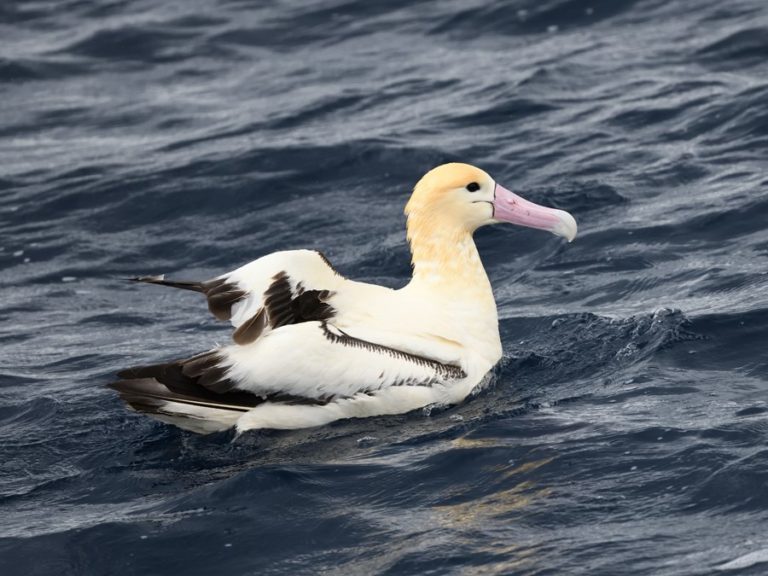
Short-tailed Albatross, adult (Stage 7). (Offshore from Torishima, Izu Islands, Japan; April 12, 2019.) © Hiroyuki & Shoko Tanoi
The undersides of the wings are mostly white, with a black border. This border is fairly wide on the primaries and the trailing edge of the secondaries, and very thin on the inner half of the leading edge.
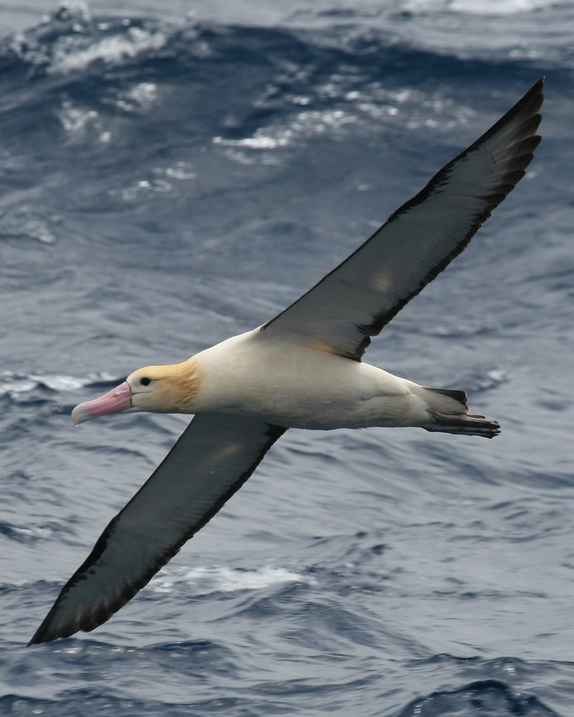
Short-tailed Albatross, adult (Stage 7). (Offshore from Torishima, Izu Islands, Japan; May 1, 2008.) © Robert Tizard
Young Immature Plumages (Stage 1). Juveniles are entirely dark-brown, with a contrasting pink bill—a combination that is unique among albatrosses. The plumage remains brown overall for two to three years, but lightens.
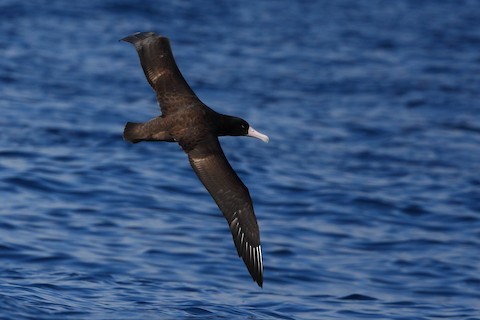
Short-tailed Albatross, immature (Stage 1) showing mostly dark-brown upperparts and contrasting pale-pink bill. (Offshore from Westport, Washington; September 21, 2019.) © Tony Moline
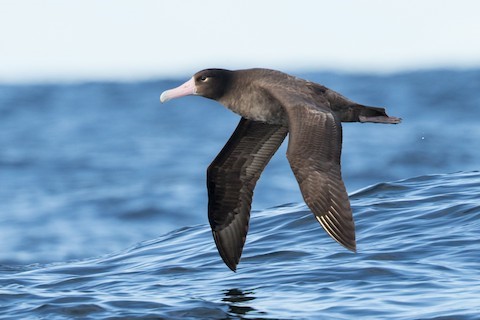
Short-tailed Albatross, immature (Stage 1), showing mostly brown plumage with darker head some paler areas, and contrasting pale-pink bill. (Offshore from Tofino, British Columbia; March 24, 2018.) © Ilya Povalyaev

Short-tailed Albatross, immature (Stage 1) showing mostly dark-brown upperparts and contrasting pale-pink bill. (Offshore from Westport, Washington; July 10, 2021.) © Jefferson Ashby
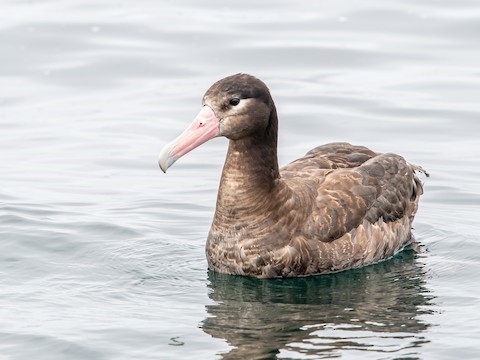
Short-tailed Albatross, immature (Stage 1-2) with mottled plumage. (Monterey Bay, California; September 15, 2021.) © Brad Lewis
Older Immature Plumages (Stage 2). Older immatures remain entirely dark-brown above, while their underparts lighten.
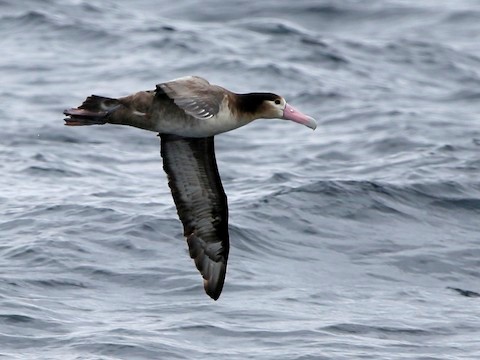
Short-tailed Albatross, immature (Stage 2). (Offshore west of Adak Island, Alaska; May 17, 2016.) © Laura Keene
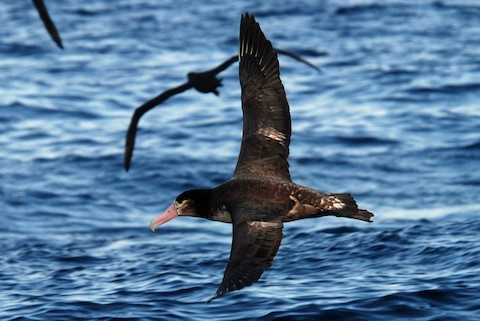
Short-tailed Albatross, immature (Stage 2) with pale underparts but mostly dark-brown upperparts—note whitish “windows” on the secondaries. (Offshore from Torishima, Izu Islands, Japan; April 16, 2009.) © Nigel Voaden
Subadult Plumages (Stages 3-4). By about four to six years of age (for males versus females), the underparts are essentially all-white, while the upperparts whiten on the rump first (in Stage 3) and then on the back (Stage 4).
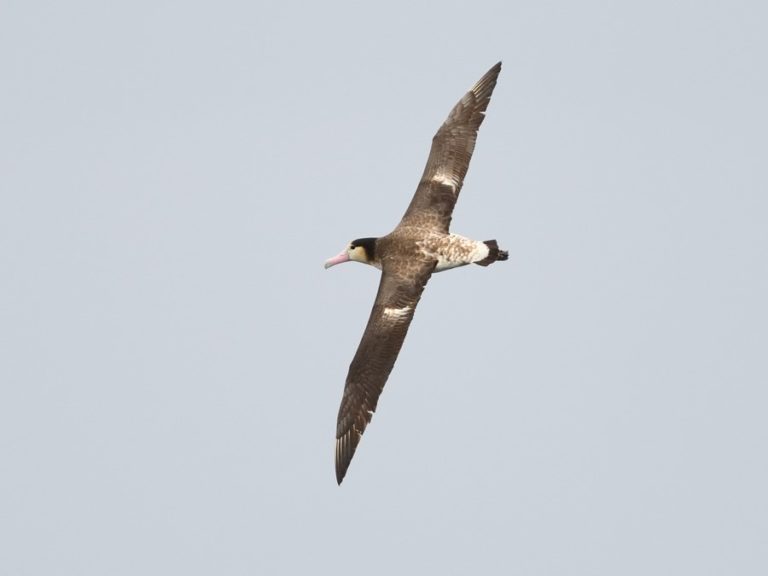
Short-tailed Albatross, subadult (Stage 3) with white rump and mottled lower back. (Offshore from Torishima, Izu Islands, Japan; April 12, 2019.) © Hiroyuki & Shoko Tanoi
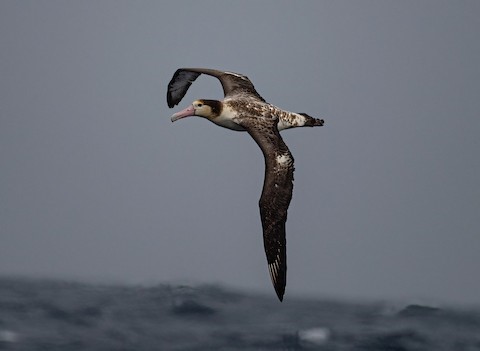
Short-tailed Albatross, subadult (Stage 3-4) with white rump and upper back. (Offshore northeast of Keelung, Taiwan; May 4, 2021.) © Jimmy Yao
Young Adult Plumages (Stages 5-6). By about seven to ten years of age (sooner in males), the upperparts are almost all-white except for some brownish feathers on the upper back.
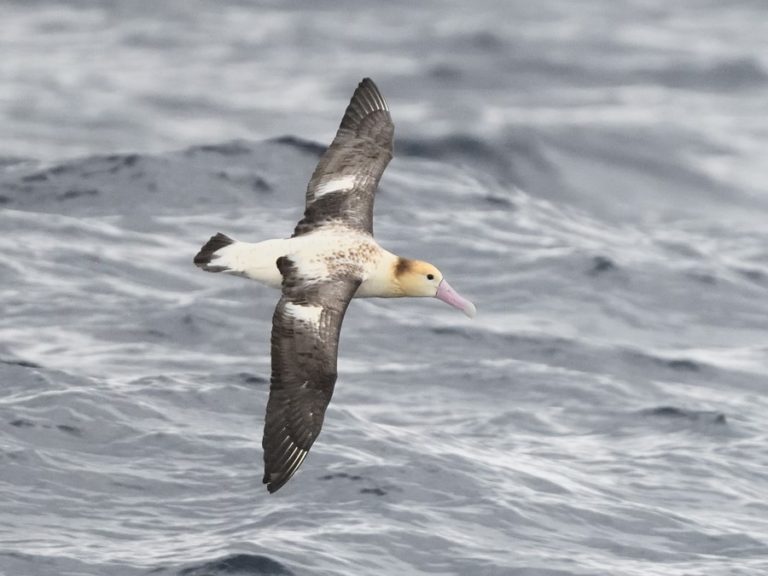
Short-tailed Albatross, adult (Stage 5). (Offshore from Torishima, Izu Islands, Japan; April 12, 2019.) © Hiroyuki & Shoko Tanoi

Short-tailed Albatross, adult (Stage 6). (Offshore from Torishima, Izu Islands, Japan; April 12, 2019.) © Hiroyuki & Shoko Tanoi
In Stage 5, the head is largely buffy-orange, but remains dark brown on the nape, and the uppersides of the wings are still almost all-black, with white windows on the secondary coverts.
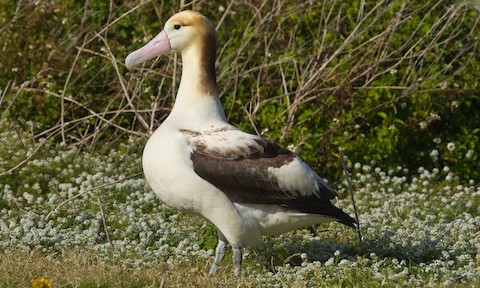
Short-tailed Albatross, adult (Stage 5). (Sand Island, Midway Atoll National Wildlife Refuge, Hawaii; February 15, 2012.) © Eric VanderWerf
In Stage 6, the nape is buffy and the white on the upperwings is slightly more extensive—this becomes more extensive in the definitive Stage 7 plumage.
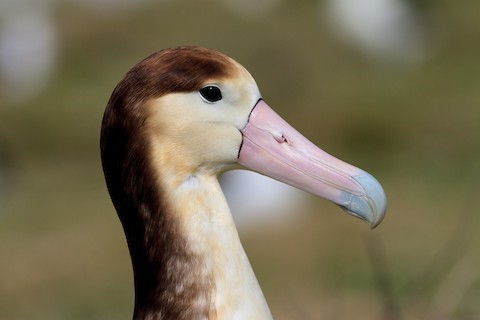
Short-tailed Albatross, subadult (Stage 3)—the head and neck of subadults and adults from Stage 3 to Stage 6 gradually changes from brown to buffy. (Sand Island, Midway Atoll National Wildlife Refuge, Hawaii; March 2, 2010.) © Ron Horn
Notes
Monotypic species.
IUCN Status: Vulnerable.
See below for comparison of Short-tailed Albatross with Black-footed and Snowy Albatrosses.
Cf. Black-footed Albatross. Black-footed is usually the only all-dark albatross present in most parts of the North Pacific, except for immatures of the rare but increasing Short-tailed Albatross. The difference is usually obvious, as Short-tailed is significantly larger and typically shows a bright, bubblegum-pink bill, whereas Black-footed’s bill is generally either black or some shade of brown.
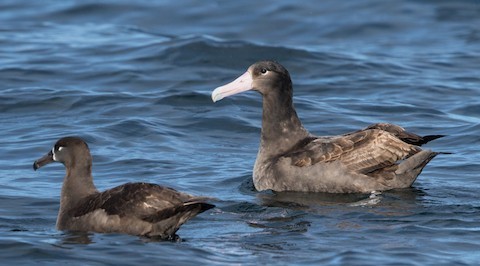
Black-footed and immature Short-tailed (at right) Albatross. (Offshore from Tofino, British Columbia; March 24, 2018.) © Ilya Povalyaev
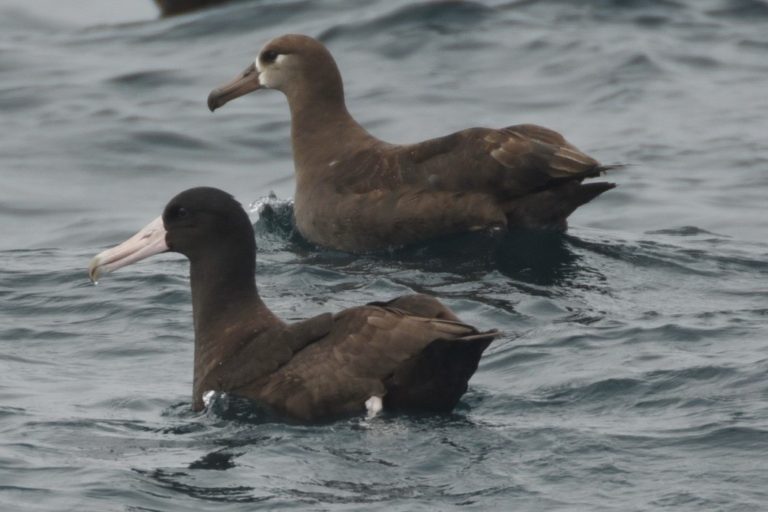
Immature Short-tailed (foreground) and Black-footed Albatross. (Offshore from Baranof Island, Alaska; July 2017.) © cedarleaf

Black-footed and immature Short-tailed (foreground) Albatross. (Offshore from Torishima, Izu Islands, Japan; April 12, 2019.) © Hiroyuki & Shoko Tanoi
Nevertheless, juvenile Short-tailed has a dark bill and Black-footed’s bill lightens with age, so there can be exceptions to the usual difference in bill color.
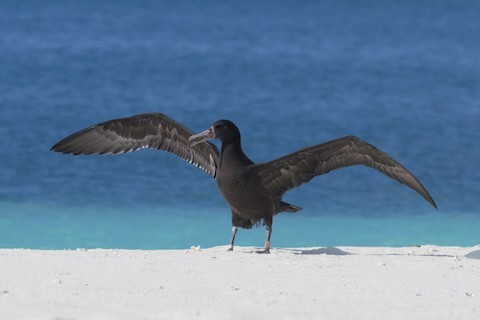
Short-tailed Albatross, recently fledged juvenile with dark bill. (Sand Island, Midway Atoll National Wildlife Refuge, Hawaii; May 30, 2020.) © Jonathan Plissner
Cf. Snowy Albatross. The Short-tailed Albatross generally resembles the great albatrosses of the Southern Hemisphere, but they overlap very rarely—only when one wanders into the wrong ocean. Like the great albatrosses, Short-tailed has a pink bill and goes through a long series of plumages over many years before reaching its definitive adult plumage. The series differ substantially, but identification generally requires comparison of multiple images because the great albatrosses are confusingly similar and the key details for distinguishing them change with age.
Young immature Short-taileds differ from all of the great albatrosses in having all-dark plumage or mostly dark with a paler belly. Subadult Short-taileds differ in having a brown cap and nape with a buffy-orange wash on the face. Adult Short-tailed differs from the great albatrosses in having a mostly buffy-orange head, and in having a distinctive “wings-upon-wings” pattern of white on mostly black upperwings. Among the great albatrosses, only the Snowy Albatross typically shows a buffy wash—on the Snowy, the buffy color is localized around the ear coverts or the side of the neck, not nearly as extensive as on Short-tailed.
Additional Photos of Short-tailed Albatross
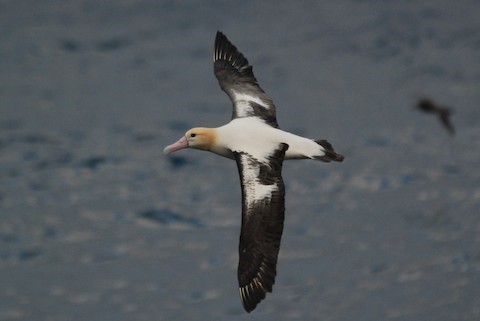
Short-tailed Albatross, adult (Stage 6). (Offshore from Torishima, Izu Islands, Japan; April 16, 2009.) © Nigel Voaden

Short-tailed Albatross, adult (Stage 5). (Offshore from Chiba, Honshu, Japan; May 1, 2021.) © Carlos Ibañez

Short-tailed Albatross, adult (Stage 5). (Offshore from Torishima, Izu Islands, Japan; April 20, 2006.) © Hiroyuki Tanoi

Short-tailed Albatross, immature (Stage 2-3). (Offshore from Torishima, Izu Islands, Japan; April 16, 2009.) © Nigel Voaden
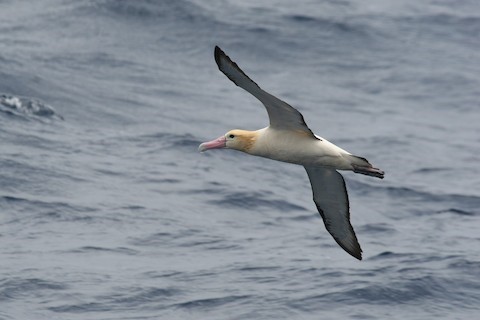
Short-tailed Albatross, adult (Stage 7). (Offshore from Torishima, Izu Islands, Japan; May 1, 2008.) © Robert Tizard
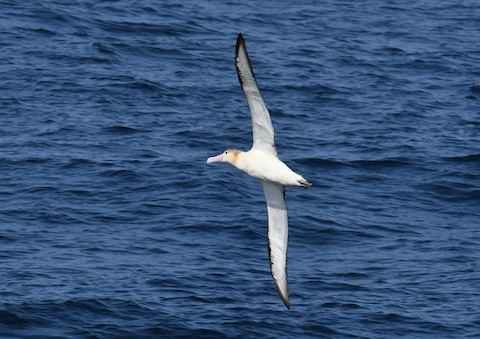
Short-tailed Albatross, adult (Stage 7). (Offshore north of Miyakejima, Izu Islands, Japan; March 31, 2018.) © Fumihiro Semba
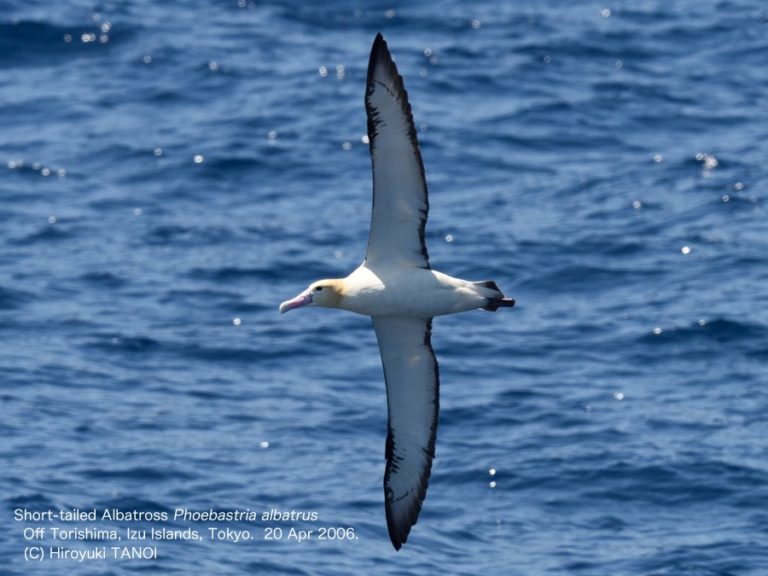
Short-tailed Albatross, adult (Stage 7). (Offshore from Torishima, Izu Islands, Japan; April 20, 2006.) © Hiroyuki Tanoi
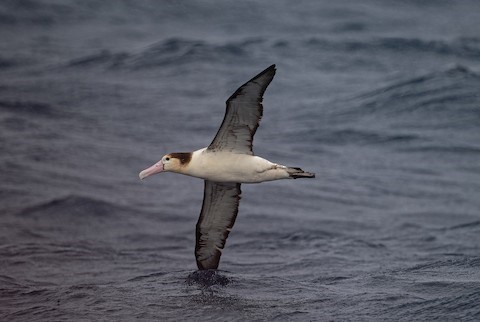
Short-tailed Albatross, subadult (Stage 3-4). (Offshore northeast of Keelung, Taiwan; May 4, 2021.) © Jimmy Yao
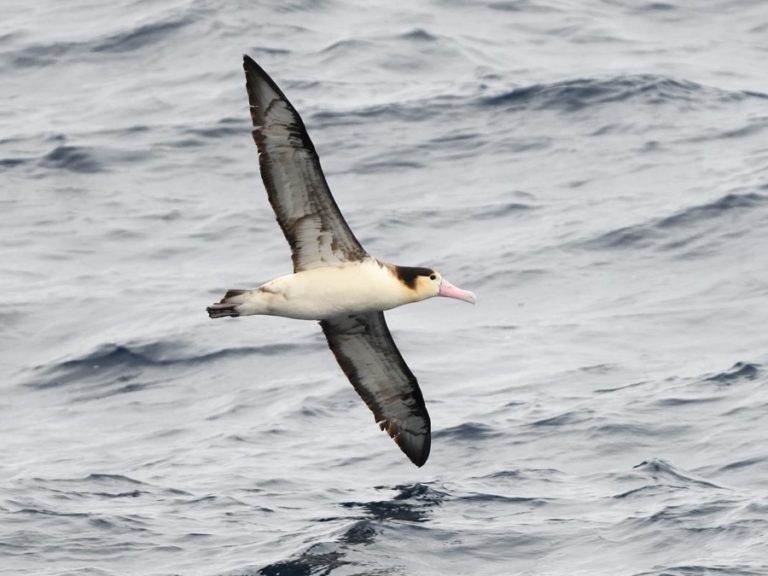
Short-tailed Albatross, subadult (Stage 3). (Offshore from Torishima, Izu Islands, Japan; April 12, 2019.) © Hiroyuki & Shoko Tanoi
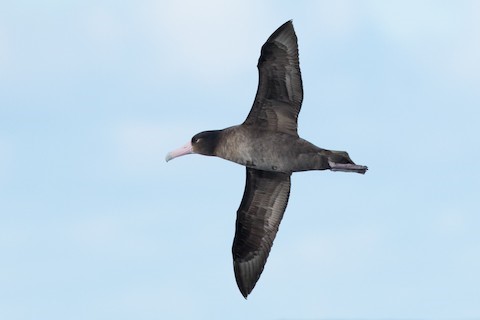
Short-tailed Albatross, immature (Stage 1). (Offshore from Tofino, British Columbia; March 24, 2018.) © Ilya Povalyaev

Short-tailed Albatross, immature (Stage 1). (Offshore from Tofino, British Columbia; March 17, 2019.) © Ilya Povalyaev
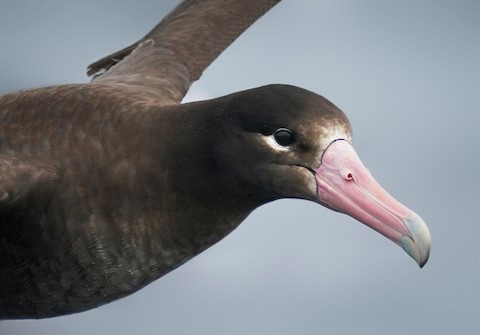
Short-tailed Albatross, immature (Stage 1). (Offshore from Long Beach, California; June 6, 2021.) © Derek Hameister
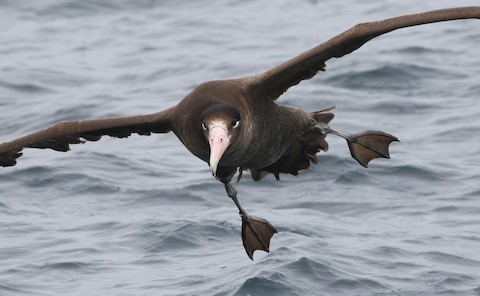
Short-tailed Albatross, immature (Stage 1). (Offshore from Long Beach, California; June 6, 2021.) © Matthew Grube

Short-tailed Albatross, immature (Stage 1). (Offshore from Baranof Island, Alaska; July 2017.) © cedarleaf
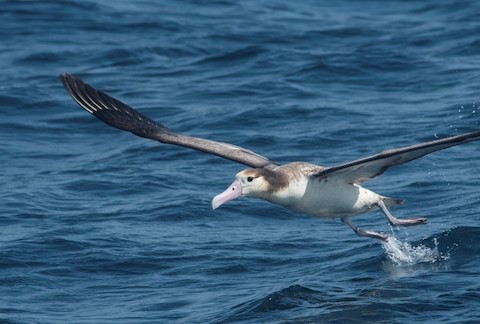
Short-tailed Albatross, subadult (Stage 3-4). (Offshore from Chiba, Honshu, Japan; May 1, 2021.) © Carlos Ibañez
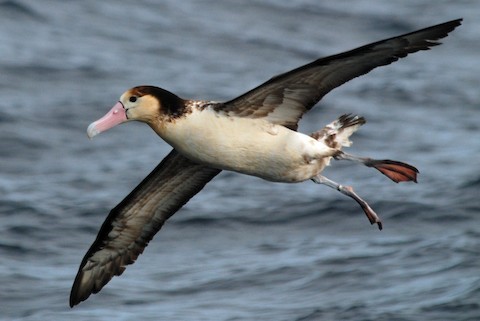
Short-tailed Albatross, subadult (Stage 3). (Offshore from Torishima, Izu Islands, Japan; April 16, 2009.) © Nigel Voaden
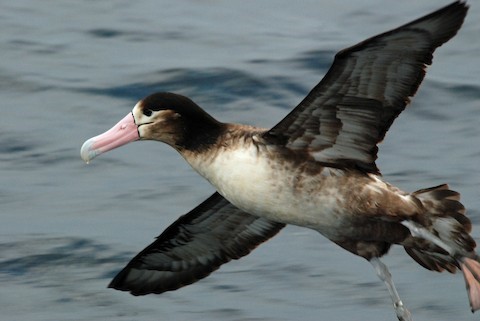
Short-tailed Albatross, immature (Stage 2). (Offshore from Torishima, Izu Islands, Japan; April 16, 2009.) © Nigel Voaden
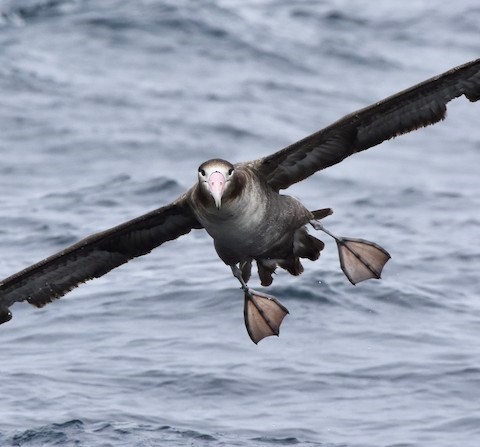
Short-tailed Albatross, immature (Stage 2). (Seguam Pass, Alaska; June 6, 2017.) © Lizabeth Southworth
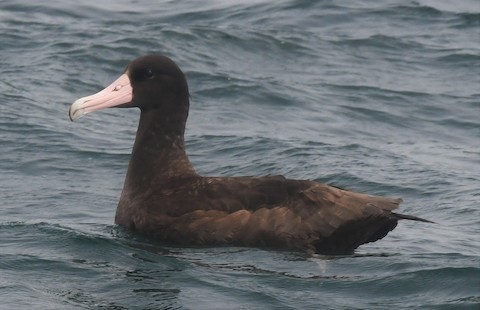
Short-tailed Albatross, immature (Stage 1). (Offshore from Westport, Washington; July 29, 2021.) © David True
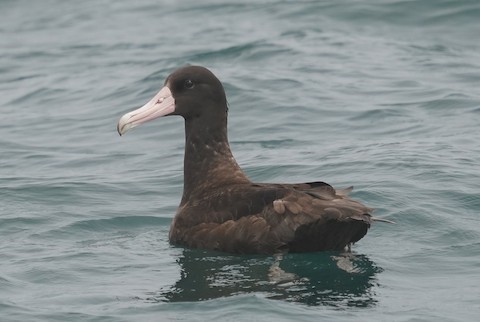
Short-tailed Albatross, immature (Stage 1). (Offshore from Westport, Washington; July 29, 2021.) © Teri Zambon True
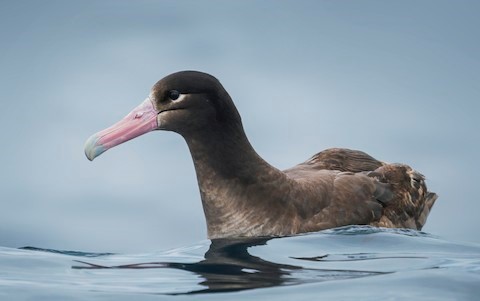
Short-tailed Albatross, immature (Stage 1). (Offshore from Long Beach, California; June 6, 2021.) © Derek Hameister
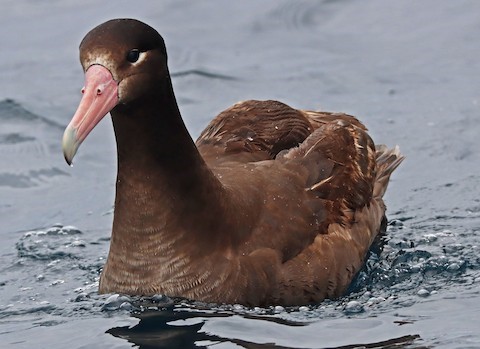
Short-tailed Albatross, immature (Stage 1). (Offshore from Long Beach, California; June 6, 2021.) © Catherine Jacobs
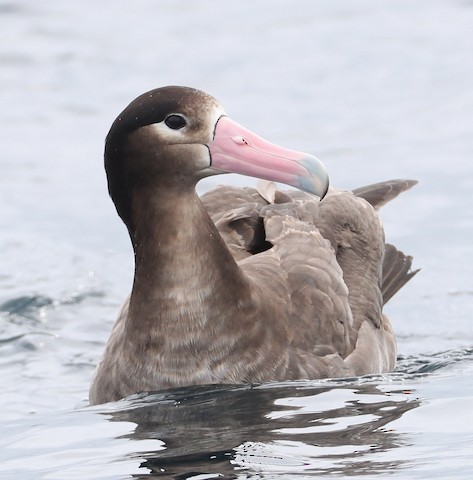
Short-tailed Albatross, immature (Stage 1). (Seguam Pass, Alaska; June 5, 2017.) © Hal and Kirsten Snyder
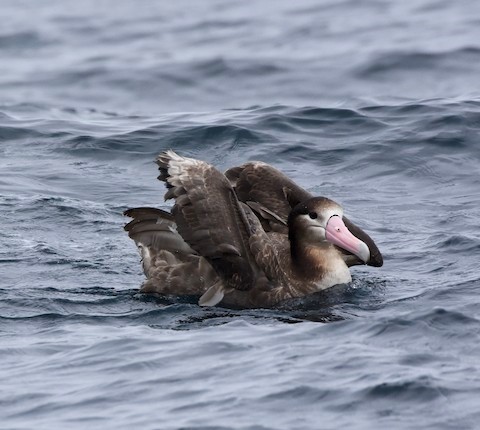
Short-tailed Albatross, immature (Stage 2). (Seguam Pass, Alaska; June 6, 2017.) © Lizabeth Southworth
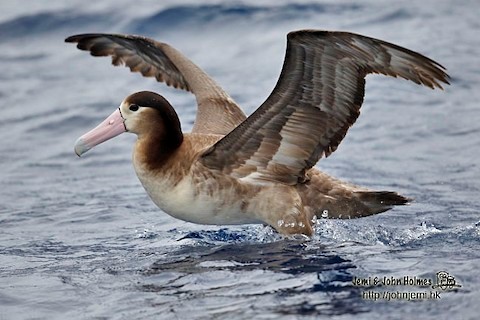
Short-tailed Albatross, immature (Stage 2). (Offshore from Minamitorishima, Izu Islands, Japan; May 10, 2015.) © Jemi and John Holmes
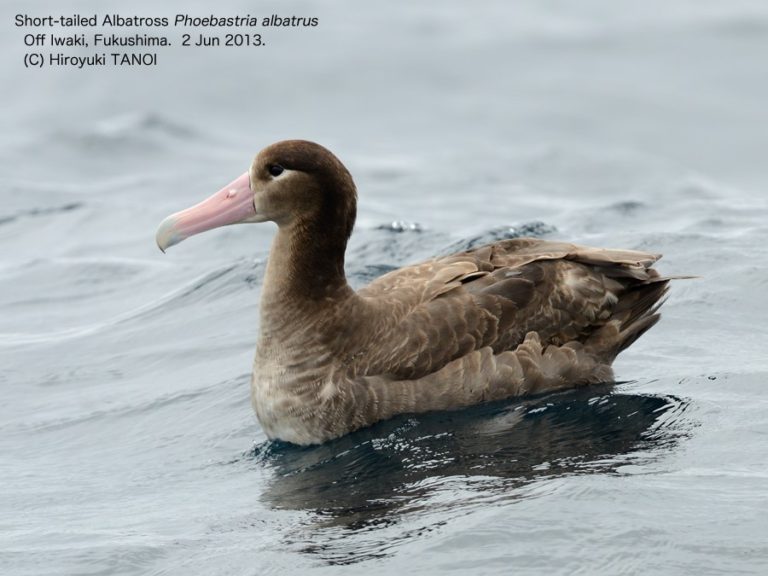
Short-tailed Albatross, immature (Stage 1). (Offshore from Iwaki, Fukushima, Honshu, Japan; June 2, 2013.) © Hiroyuki Tanoi

Short-tailed Albatross, subadult (Stage 3). (Offshore from Torishima, Izu Islands, Japan; April 16, 2009.) © Nigel Voaden
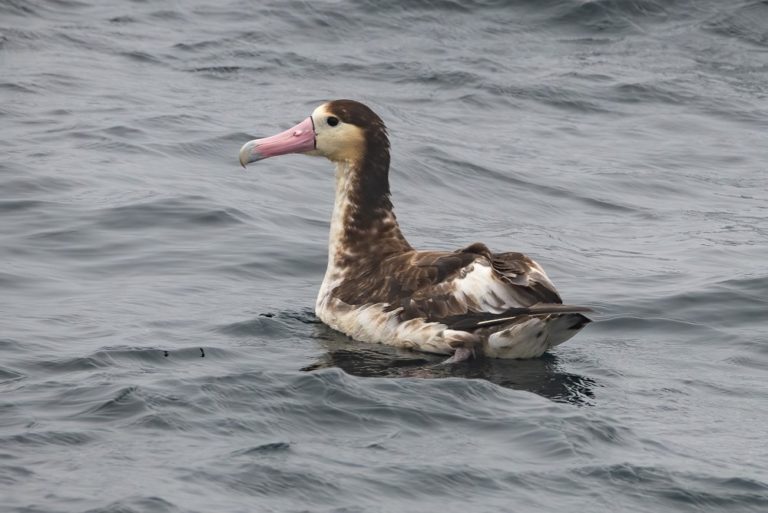
Short-tailed Albatross, subadult (Stage 3). (Kurile Islands, Russia; June 2019.) © Carolyn Stewart

Short-tailed Albatross, subadult (Stage 4). (Seguam Pass, Alaska; June 6, 2017.) © Todd Deininger

Short-tailed Albatross, subadult (Stage 3-4). (Seguam Pass, Alaska; June 5, 2017.) © Lizabeth Southworth
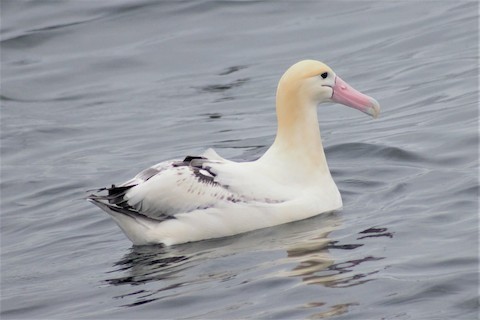
Short-tailed Albatross, adult (Stage 7). (Offshore west of Attu Island, Alaska; October 4, 2020.) © Jessica Rich

Short-tailed Albatross, subadult (Stage 3-4). (Offshore from Torishima, Izu Islands, Japan; April 16, 2009.) © Nigel Voaden
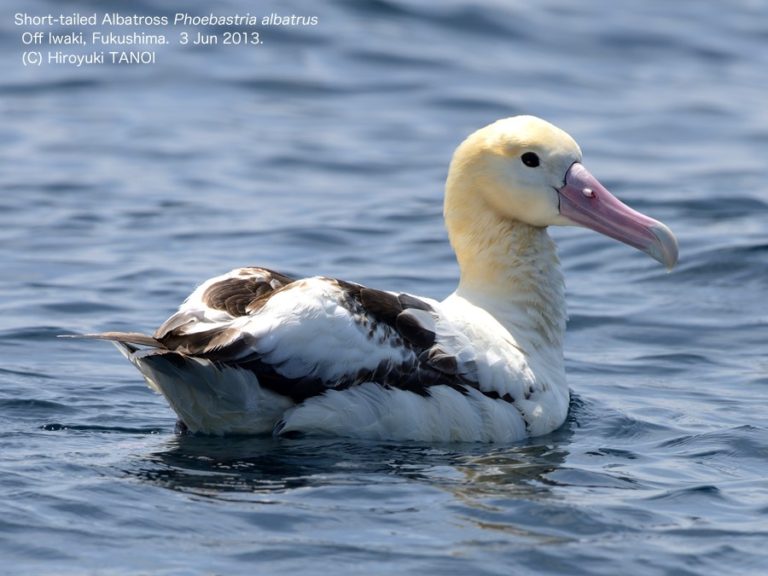
Short-tailed Albatross, adult (Stage 6-7). (Offshore from Iwaki, Fukushima, Honshu, Japan; June 3, 2013.) © Hiroyuki Tanoi
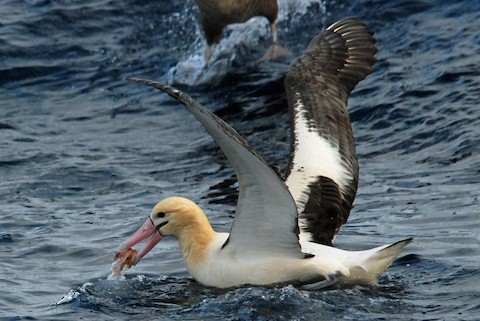
Short-tailed Albatross, adult (Stage 7). (Offshore from Torishima, Izu Islands, Japan; April 16, 2009.) © Nigel Voaden
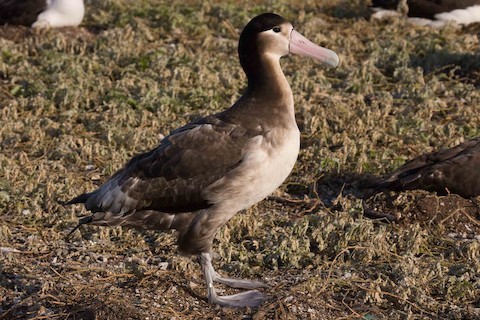
Short-tailed Albatross, immature (Stage 2). (Eastern Island, Midway Atoll National Wildlife Refuge, Hawaii; December 16, 2008.) © Eric VanderWerf

Short-tailed Albatross, subadult (Stage 3). (Sand Island, Midway Atoll National Wildlife Refuge, Hawaii; March 2, 2010.) © Ron Horn
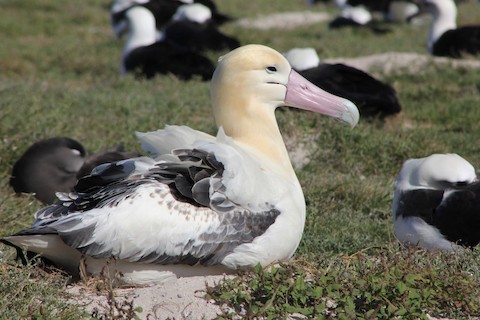
Short-tailed Albatross, adult on nest. (Sand Island, Midway Atoll National Wildlife Refuge, Hawaii; December 11, 2019.) © Will Kennerley
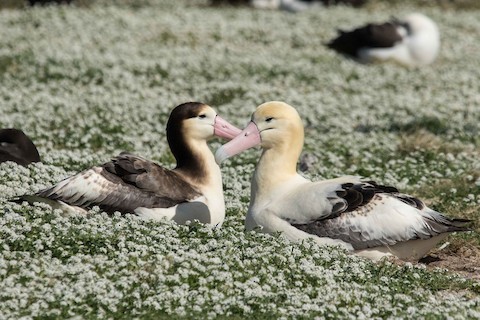
Short-tailed Albatross, subadult and adult. (Sand Island, Midway Atoll National Wildlife Refuge, Hawaii; February 15, 2017.) © Eric VanderWerf
References
Alderfer, J., and J.L. Dunn. 2014. National Geographic Complete Birds of North America (Second Edition). National Geographic Society, Washington, D.C.
BirdLife International. 2018. Phoebastria albatrus. The IUCN Red List of Threatened Species 2018: e.T22698335A132642113. https://dx.doi.org/10.2305/IUCN.UK.2018-2.RLTS.T22698335A132642113.en. (Accessed December 11, 2021.)
Brazil, M. 2009. Birds of East Asia. Princeton University Press.
eBird. 2021. eBird: An online database of bird distribution and abundance. Cornell Lab of Ornithology, Ithaca, N.Y. http://www.ebird.org. (Accessed December 11, 2021.)
Harrison, P. 1983. Seabirds: An Identification Guide. Houghton Mifflin, Boston.
Howell, S.N.G. 2012. Petrels, Albatrosses & Storm-Petrels of North America. Princeton University Press.
Howell, S.N.G., and K. Zufelt. 2019. Oceanic Birds of the World. Princeton University Press.
Onley, D., and P. Scofield. 2007. Albatrosses, Petrels & Shearwaters of the World. Princeton University Press.
Pyle, R.L., and P. Pyle. 2017. The Birds of the Hawaiian Islands: Occurrence, History, Distribution, and Status. Version 2 (January 1, 2017). http://hbs.bishopmuseum.org/birds/rlp-monograph/. B.P. Bishop Museum, Honolulu, Hawaii.
Seabirding of Japan. 2021. Short-tailed Albatross. https://seabirding-japan.com/short-tailed-albatross/. (Accessed December 11, 2021.)
Xeno-Canto. 2021. Short-tailed Albatross – Phoebastria albatrus. https://www.xeno-canto.org/species/Phoebastria-albatrus. (Accessed December 11, 2021.)

